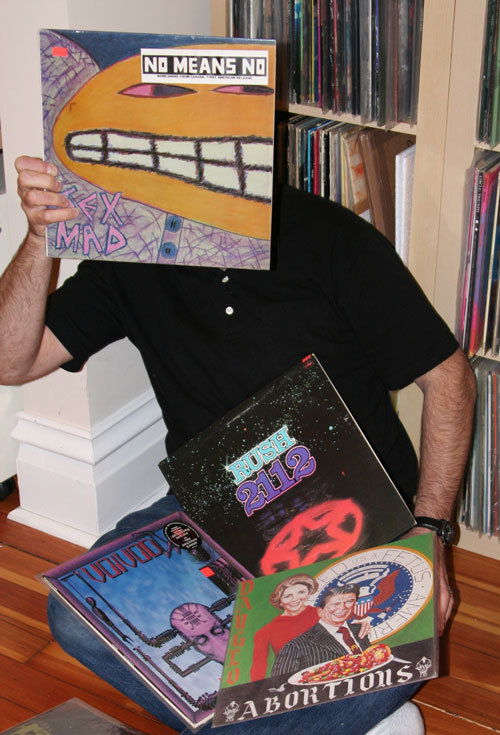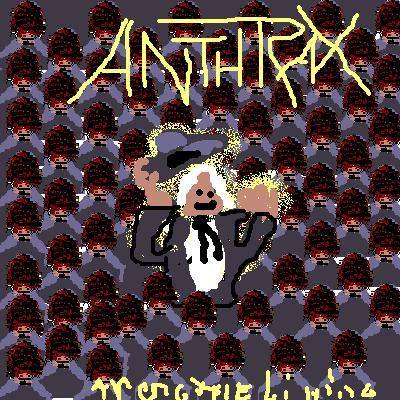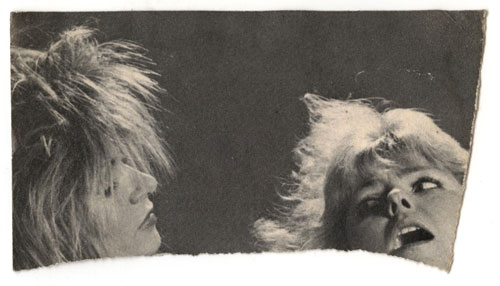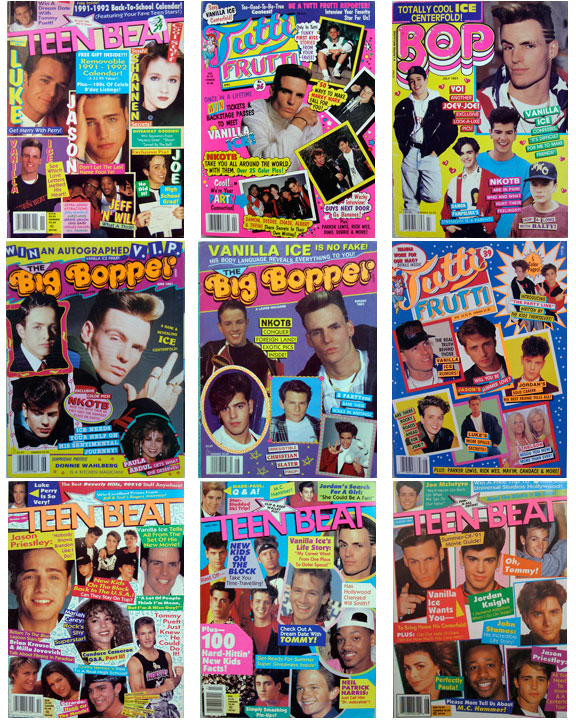"A Reference Librarian of My Own Crap": Interview With Marc Fischer of Public Collectors

Marc Fischer, with special Canadian records from his seemingly vast collection.
Marc Fischer thinks we all need to embrace our inner archivist. "As government and private funding for the arts and humanities continues to shrivel up, individuals need to step up and make cultural and material resources more accessible," explains the Chicago-based artist. "Many towns that have poor museums and libraries are filled with individuals that are sitting on amazing collections in their homes."
With that in mind, Fischer founded Public Collectors, a digital archive of eclectic collections. Many of the collections are his own, but anyone is welcome to submit their particular obsessions. Fischer admits that much of what's shown on Public Collectors would never make it to a museum vitrine; among the amassments are a long list of songs about food, a museum of Vanilla Ice promo material, and—my favourite—Album Covers Recreated with MS Paint. Some of the collections are only viewable online. Others, more ambitiously, include contact information and an offer from their owners to visit them in person.
Public Collectors is generous in its scope, both in its classifications and its insistence that collectors open their doors to interested strangers. And despite the seemingly ironic Vanilla Ice paraphernalia and occasional smut, it is earnest; Fischer truly believes we should be profuse with what we've been lucky enough to find.
Fischer, who describes himself as "a terrible pack rat and obsessive collector," got his start during high school in the late '80s, when he published an underground metal, punk and activism zine. He went to become an artist and the co-founder of a group called Temporary Services, through which he also co-runs a small publishing imprint called Half Letter Press.
Maisonneuve corresponded with Fischer by email, and talked about why elitism is limiting, accessibility is everything, and how to walk the fine line between collecting and hoarding.

From the digital collection Face Painting Options at Vendor Booths in Mexico City
Madeline Coleman: How did you come up with the idea for Public Collectors?
Marc Fischer: The kind of creative work I generally find most interesting exists on the margins. Most of the things I care about and am inspired by are not mainstream. While the internet has made all kinds of obscure cultural materials visible digitally, I think direct tactile experiences are extremely important, and more invigorating than just hearing a great mp3 or looking at a beautiful jpg.
The best resources for the kinds of things I'm interested in are generally in people's homes. The best resources for the things I've made are largely in the homes of various friends, collaborators and curators. Temporary Services has made ninety publications and while some libraries have some copies of them, many more copies are in the homes of people we've come into contact with over the years. Even though almost no one has a complete set of our publications, many people may have twenty different ones, which is a lot of material to be able to share.
Over the years, I've accumulated a lot of stuff produced by other people: a lot of publications and printed ephemera that I've traded for, or been given by others. I've become an informal archivist of many people's and artist groups' work. I also accumulate materials as a result of teaching and gathering resources for my pedagogical work or research materials for art projects.
While I'm glad I get to live with this stuff, I think it should be seen by more people. I think it should be more broadly disseminated online in many cases, but also have its availability announced—in case someone is passing through Chicago and wants to see things in person, lives elsewhere but has a research question I might be able to answer in an email, or in case someone is organizing an exhibit and might want to borrow an item.
Basically, I wanted to avail myself as a kind of reference librarian of my own crap, with the hope that others would also try to be a bit less secretive about their collections and a bit more generous with their knowledge and resources.
Even if they don't want to open their homes to people, they could take some time out to bring objects somewhere else, like a free meeting room at a public library, or put hopelessly obscure things online so that someone else can benefit. With a one-hundred-dollar scanner you can scan a rare publication, or hundreds of photos no one has seen before, and share them with many thousands of people using a free blog. Obviously many people are already doing this, which is great.

From the digital collection Album Covers Recreated with MS Paint
MC: Both Temporary Services and Public Collectors stress accessibility, a desire to "de-rarify" art and collections. Why is this so important?
MF: So much of the art world is structured to create the feeling of exclusivity. Architecture, social behaviours and admission fees are commonly used to create an atmosphere of exclusion. People are priced out of getting to see extraordinary objects or are made to feel like they don't belong in certain kinds of cultural spaces.
However, when you ask artists who the audience for their work is, most will say, "It's for everyone." But clearly most museums and galleries are not intended for everyone, otherwise they'd be designed or organized very differently. This is obvious when you walk into those places, or work in them, as I have done in the past for about nine years.
While museums still have some value to me as a visitor and occasionally as an exhibitor, for the most part they are not where I go for information and ideas. As I get older I find myself increasingly put off with how sterile most museums feel and how expensive they are to visit. I often prefer to pay a dollar to go to a huge flea market, where I can see thousands of things in no particular order, talk to people about the stuff they are selling, eat cheap food at 6:30 in the morning on a Sunday, and have a much more hands-on experience.
With both Temporary Services and in my own practice, we have always represented ourselves. We don't have gallerists that respond to things on our behalf or coordinate things for us. People can rarify what I do when I'm dead, if anyone is still interested.
When I'm alive, I want to be directly involved in how my work goes out into the world, available if someone has a question, and an active participant in the discourse around my creative practice.
Likewise, it has been a very refreshing experience when someone whose work I am inspired by has made themselves available to my inquiries. I have been deeply moved by the generosity of so many more established artists that have availed themselves when I've wanted to learn about their experiences.
In everything I do I wish to expand the audiences for creative work—my own and by others—and particularly for things that have a more experimental bent, or have been excluded from normal modes of presentation or preservation.

From the digital collection Torn Porn
MC: You stipulate that those who want to submit collections must provide contact information so that interested parties might be able to visit their stuff. Why? How successful has this aspect of Public Collectors been—do visitors to the site take advantage of this possibility?
MF: I want people to provide contact information so that they can coordinate any interactions with people who are interested in their collections. I don't need to be involved in those communications and it's more streamlined if I stay out of the way.
Unfortunately, by far the most dominant experience of Public Collectors has been for the digital content. My desire to get people into the homes of others and directly in front of collections has largely not been realized. There have been a number of interesting interactions—including some very unexpected research requests—but most of the participating collectors have not had many visits. Some have been contacted for other reasons though, including interviews, articles, object loan requests for exhibits, or by artists in their collections who want to give the collector more things because they were moved that someone was offering to share their work from home.
What has been more effective for in-person sharing is to just organize exhibitions and events with designated locations, times and schedules where people can come see a focused collection, or peruse a subset of a larger collection. There have been several Public Collectors events like this and I hope to do more in the future, as time permits.
MC: I'm going to play the devil's advocate for a second: why is it important that we all be able to access a collection of Vanilla Ice memorabilia, for example? What if I don't think this is "important" enough to archive?
MF: I don't expect to everyone to find all collections interesting or important, or to find all things worth saving. I certainly don't, but if someone is willing to do the work to inventory a collection and is willing to share it, I'll help them participate in the project and publicize their collections.
Brent Birnbaum's Vanilla Ice collection is a serious challenge to some people's ideas of what is worth acquiring or making space for. But even if you hate Vanilla Ice's music, it still might be possible to find something compelling in the endless minute variations in how he is depicted and in the merchandising that happened around this one person at the height of their popularity. I can think of the collection as a detailed look at how fleeting stardom can be, or valuable for the range of ways that one entertainer was commodified.
To me, the depth of Brent's interest and the scope of that collection is a kind of entertainment in and of itself, despite my lack of interest in the subject. I'm energized by the passion he has poured into that very obsessive endeavour.

From the public collection To the Extreme: The Vanilla Ice Museum
MC: At one point does something become a collection? I wonder if you might have started looking at your favourite things differently after starting Public Collectors—maybe realize a predilection for certain kinds of things actually stemmed from a desire to collect.
MF: Many people seem to think that collections should be large, or consist of objects with considerable monetary value, or else they are not substantial. There are some great magazines that only produced seven issues, and if someone had all seven issues that would be a great collection of that magazine and a full experience for someone who was interested.
I guess I judge a collection by the depth of the experience it provides. Sometimes this is dependent on quantity, other times on the diversity and range of objects within a more modest selection, or on what kind of insights the collector might bring to the things they have. Part of what I'm after with Public Collectors is not just for people to share their stuff, but to be available to share their insights about the things they own, no matter how large or small the collection is.
Public Collectors—particularly working on the Tumblr—has made me look harder at the things in my own home. Maybe I don't want to scan an entire out-of-print book, but scanning one great drawing might be something that gives thousands of people pleasure when I post it online. It has been gratifying to see a lot of excitement generated by making even small things or fragments of things available when dealing with stuff that people had never seen before. Sometimes this opens up larger discussions and generates deeper interest than I realized existed.
MC: At what point does collecting become hoarding?
MF: I'm certainly not an expert on hoarding, which is a very real disorder, but I think it's interesting to explore this boundary between collecting and just accumulating.
Collecting has its own psychological issues but when one has so much stuff and it's so disorganized that it can't be easily accessed, thought about, studied, enjoyed or shared, then I think the objects cease to function as collections should. Even the collector or hoarder isn't really taking advantage of owning the thing at that point, and it certainly can't be seen by anyone, including the owner, if it's buried under 500 pounds of food garbage, dirty clothing, cat skeletons, and whatever else!
All images courtesy of Public Collectors. For Marc Fischer's most recent acquisitions, see the Public Collectors tumblr.
Related on maisonneuve.org:
—We’ll Never Be That Drunk Again
—This Is My Brain on Facebook
—Interview With a Guy Who Tests Tape
Subscribe — Follow Maisy on Twitter — Like Maisy on Facebook





